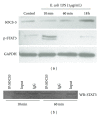SOCS3 expression correlates with severity of inflammation, expression of proinflammatory cytokines, and activation of STAT3 and p38 MAPK in LPS-induced inflammation in vivo
- PMID: 24078776
- PMCID: PMC3775441
- DOI: 10.1155/2013/650812
SOCS3 expression correlates with severity of inflammation, expression of proinflammatory cytokines, and activation of STAT3 and p38 MAPK in LPS-induced inflammation in vivo
Abstract
SOCS3 is an inducible endogenous negative regulator of JAK/STAT pathway, which is relevant in inflammatory conditions. We used a model of LPS-induced periodontal disease in rats to correlate SOCS3 expression with the inflammatory status. In vitro we used a murine macrophage cell line to assess the physical interaction between SOCS3 and STAT3 by coimmunoprecipitation. 30 ug of LPS from Escherichia coli were injected in the gingival tissues on the palatal aspect of first molars of the animals 3x/week for up to 4 weeks. Control animals were injected with the vehicle (PBS). The rats were sacrificed at 7, 15, and 30 days. Inflammation and gene expression were assessed by stereometric analysis, immunohistochemistry, RT-qPCR, and western blot. LPS injections increased inflammation, paralleled by an upregulation of SOCS3, of the proinflammatory cytokines IL-1 β , IL-6, and TNF- α and increased phosphorylation of STAT3 and p38 MAPK. SOCS3 expression accompanied the severity of inflammation and the expression of proinflammatory cytokines, as well as the activation status of STAT3 and p38 MAPK. LPS stimulation in a macrophage cell line in vitro induced transient STAT3 activation, which was inversely correlated with a dynamic physical interaction with SOCS3, suggesting that this may be a mechanism for SOCS3 regulatory function.
Figures





References
-
- Taubman MA, Valverde P, Han X, Kawai T. Immune response: they key to bone resorption in periodontal disease. Journal of Periodontology. 2005;76(supplement 11):2033–2041. - PubMed
-
- Souza PPC, Palmqvist P, Lundgren I, et al. Stimulation of IL-6 cytokines in fibroblasts by toll-like receptors 2. Journal of Dental Research. 2010;89(8):802–807. - PubMed
-
- Liu YG, Lerner UH, Teng YA. Cytokine responses against periodontal infection: protective and destructive roles. Periodontology 2000. 2010;52(1):163–206. - PubMed
-
- Starr R, Hilton DJ. Negative regulation of the JAK/STAT pathway. Bioessays. 1999;21(1):47–52. - PubMed
-
- Alexander WS, Hilton DJ. The role of Suppressors of Cytokine Signaling (SOCS) proteins in regulation of the immune response. Annual Review of Immunology. 2004;22:503–529. - PubMed
Publication types
MeSH terms
Substances
LinkOut - more resources
Full Text Sources
Other Literature Sources
Miscellaneous

